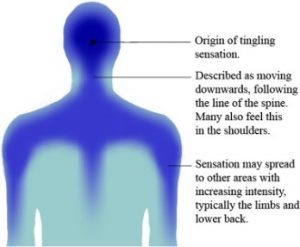While you’re reading this post, may I ask you to take a moment to pay attention to your background sound? Take a look at the picture below, and think of the smooth line in the left as the sound that is comfortable or unnoticeable to you and the wavy line in the right as the sound that is bothersome and distracting to you. Which way do you think you receive your current environmental sound?

Image by Olena Shmahalo via Quanta Magazine; noise generated by Thomas Donoghue.
Facts — Sounds Have Different Kinds
To know the impacts by different sounds on our brain, let’s start with the processing centre of the received sounds. Humans interpret sounds and process their information through cortex, the outer layer of the most anterior of the brain. When our concentration is disrupted, cortisol – the primary stress hormone – is induced and results increasing of our stress level. Excess cortisol impairs functions in the most front of cortex. Thus, when cortex is affected by noise from the outside environment, brain capacity to think clearly and to retain information is compromised.
However, you may have noticed that sometimes you seem to endure some outside sounds and have no issue with concentration. Such sounds are called neutral, to which people do not have much reaction. On the other hand, the sounds that are unpleasant and disturbing are called triggering sounds, which include eating, pen clicking, and clock ticking. When people become extremely sensitive to triggering sounds, they are emotionally affected. The phenomenon is called: Misophonia.

Image by Dr. Megan Faye via Anxiety Specialist of Atlanta.
An article by James Cartreine, PhD, Contributing Editor published on June 24, 2019 via Harvard Health Blog by Harvard Medical School titled, Misophonia: When sounds really do make you “crazy”, provided background information and facts regarding misophonia. The article described a British-based search on 20 misophonic people and 22 normal people, and the researchers noted that “persons with misophonia showed much greater physiological signs of stress (increased sweat and heart rate).” As a conclusion, it confirmed that misophonia has negative impacts on human emotions and “can lead to isolation.”
Silver Lining — ASMR Ambience
So far, it looks like that the sounds are mostly bad to people. However, if you’re browsing YouTube often, you’ll notice in recent years, “ASMR” and “ambience sounds,” such as tapping, writing, raining and fireplace imitation, are trending. Unlike neutral sounds that are unnoticeable, such sounds help many people to relax and fall asleep as well as more concentrated on working and studying.
Why is that?
University of Sheffield published a journal on June 21, 2018 via Science Daily: Brain tingles: First study of its kind reveals physiological benefits of ASMR, could have an answer to it. That is, ASMR is in fact a response to specific triggering sounds experienced by some people called “Brain-Tingle.” The pathway of how ASMR flows mentally to physically is shown as below.

Image by Emma L. Barratt, Nick J. Davis in their scientific article: “Autonomous Sensory Meridian Response (ASMR): a flow-like mental state” via The National Center for Biotechnology Information (NCBI) published online on Mar 26, 2015.
Two Sides of the Coin
ASMR and misophonia are just like two sides of the sound-impact coin. The fact that one is positive while the other is negative supports that even if the positive side cannot be a replacement for medication, its benefits for mental and physical health are therapeutic.
~ By Evelyn Zhong

 https://d2r55xnwy6nx47.cloudfront.net/uploads/2021/02/Brain-Noise_2560_Lede.jpg
https://d2r55xnwy6nx47.cloudfront.net/uploads/2021/02/Brain-Noise_2560_Lede.jpg https://i.guim.co.uk/img/media/e16e33bdce44e28c845484cf9b93efafbdcac570/0_171_5121_3073/master/5121.jpg?width=620&quality=45&auto=format&fit=max&dpr=2&s=1b96aff2315ed8ee9176c6908c50f57b
https://i.guim.co.uk/img/media/e16e33bdce44e28c845484cf9b93efafbdcac570/0_171_5121_3073/master/5121.jpg?width=620&quality=45&auto=format&fit=max&dpr=2&s=1b96aff2315ed8ee9176c6908c50f57b https://www.ncbi.nlm.nih.gov/pmc/articles/PMC4380153/figure/fig-1/
https://www.ncbi.nlm.nih.gov/pmc/articles/PMC4380153/figure/fig-1/